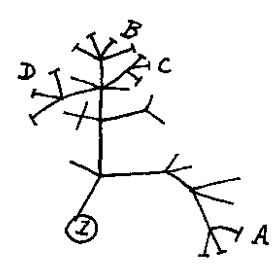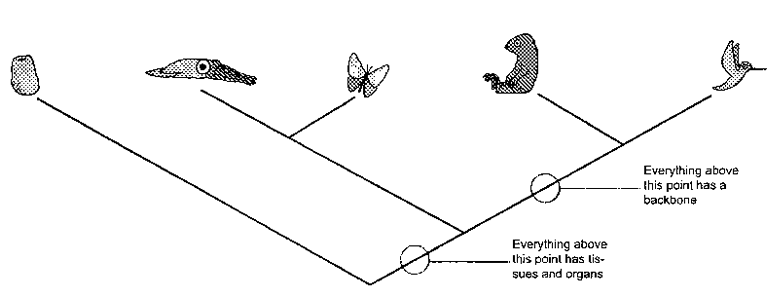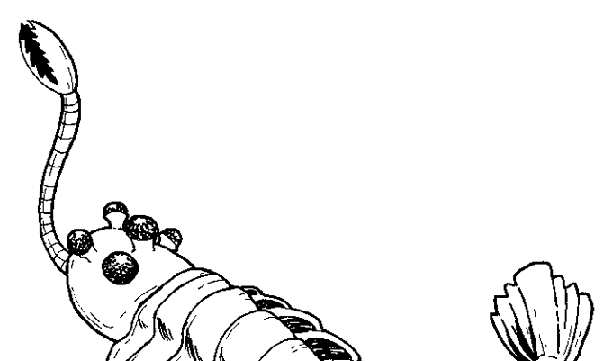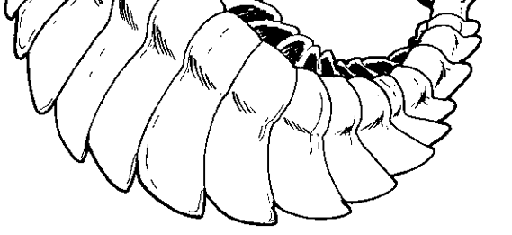














































The Tree of LifeOne of the things scientists like to do is collect, count and sort. For evolutionary biologists, sorting species into meaningful categories requires a basic understanding of how closely or distantly species are related. These relationships are often represented as a branching phylogenetic tree, a convention started by Darwin when he was formulating his theory of natural selection (Fig. 8.1). Phylogenetic trees are maps of the evolutionary patterns and histories of species. Biologists use several different lines of evidence to infer evolutionary relationships when building a tree, including genetic differences among species, comparisons of how the embryos of various species develop, comparisons of the bodies of various species and the fossil record. While phylogenetic trees are essential tools for our understanding of the history of life, in a few rare cases they can even be a matter of life and death. In 2006, an international team of health workers consisting of five Bulgarian nurses and one Palestinian doctor were accused of intentionally infecting 400 Libyan children with HIV in a Tripoli hospital in 1998. HIV is a rapidly-mutating virus and consequently can generate several different strains in a relatively short period of time. When molecular biologists from Oxford and Rome built a phylogenetic tree of the HIV strain infecting the children, they discovered that it was most closely related to HIV strains that had been in Libya since the mid 1990s, long before the arrival of the health workers. This evidence, along with intense international political pressure, eventually helped win the release of the health workers. To get a very basic understanding of how trees are built, let’s consider a less harrowing example using a squid, a sloth, a butterfly, a hummingbird and sponge. The Sorting HatSo. you put on your sorting hat and begin organizing the critters in Figure 8.2 based on their evolutionary relationships. Where do you start? When evolutionary biologists start sorting, they begin with the assumption that all life on earth started with a common ancestor who lived a couple billion years ago. In our phylogenetic tree, we want to cluster related species together in relatively close branches. To do that, we need to find ways to distinguish between one species and another. In many cases this is easier said than done. Although squid and octopuses have tentacles and are closely related, they are clearly different species. But what specifically makes them different? To answer that question, biologists look to a species unique blend of adaptations as a physical record of a species’ evolutionary history. |

Figure 8.1 Charles Darwin first sketched a tree to represent the evolutionary relationships of species in his First Notebook on Transmutation of Species (1837). 
Figure 8.2 Stuff to sort, including (clockwise from upper left) a hummingbird, butterfly, sloth, squid and sponge. See text for details. |
We have to start sorting somewhere, so let’s pick a trait. Hey! I have an idea. How about eyes? It is readily apparent that four of the five animals to be sorted have eyes, while the sponge does not. Sponges are the simplest multicellular animals on the tree of life. They live their lives as sedentary filter feeders, primarily in marine environments, and their cells are not organized into tissues (like muscles and nerves) or organs (such as eyes). By contrast, the giant squid, hummingbird, butterfly and sloth all have well developed tissues and organ systems. This is a major difference and constitutes an important evolutionary divergence.
About 900 million years ago, an organism with rudimentary organs split from the sponges (Fig. 8.3A). This new species was the ancestor of the evolutionary line that eventually led to squid, sloths, butterflies and hummingbirds. Because these four are all descended from a common ancestor, we say that they comprise a monophyletic group (mono = one, phylogeny = evolutionary history). Since members of a monophyletic group share a common ancestor, they also share some homologous traits. A homologous trait is a feature that appears similar between two species and is inherited from a common ancestor.
Homologous features can be anatomical, genetic or developmental. A classic example of anatomical homology can be seen in the bones of vertebrate forelimbs. While they vary dramatically in external appearance and perform different functions, the forelimbs of bats, seals and humans all contain the same bone structure (Fig. 8.4).
You can’t really sort the remaining four animals based on the presence of tissues and organs because that is a homologous adaptation shared by all four species in this group. But what if you sorted based on the type of adaptation, in this case the type of eye? Based on that criterion, two groups are generated: organisms with camera eyes (the giant squid, sloth and hummingbird) and those with compound eyes (the butterfly). Will that work? Not really.
Not every aspect of an organism that can be used to sort is useful in building a phylogenetic tree. Sorting based on eye type works for butterflies (Fig . 8.3B) because insects evolved compound eyes independently of organisms that evolved camera eyes (see our discussion in Chapter 3). But the important question for our phylogenetic tree becomes, “Is the group that contains the squid, sloth and hummingbird monophyletic based on their type of eye?” In other words, do these three share a common ancestor that had a camera eye? The answer is that they probably did not.

Analogous Traits and Convergent EvolutionOne of the trickiest aspects of creating a phylogenetic tree is realizing that adaptations that look like they were inherited from a common ancestor (i.e. they are homologous) often are not. Sometimes adaptations are the product of convergent evolution. As the name suggests, convergent evolution is the process by which two distantly related species evolve similar features (known as analogous traits) to deal with similar environmental conditions or similar ways of life. Thus, analogous traits are traits that perform analogous functions but have evolved independently in two species and are not inherited from a common ancestor. At first blush, the sloth’s camera eye and the squid’s camera eye look like they might be homologous traits. They are camera eyes, after all. They both have corneas and lenses that focus light. Both eyes form an image and both have retinas full of small photosensitive cells. So, from a functional standpoint, it seems like they were inherited from the same ancestor. But similarity in form and function can be deceiving. Upon closer inspection, we can identify several important differences that suggest that the two types of camera eyes evolved independently of each other. (Fig. 8.5). In some squid and octopuses, the cornea is actually open to the environment. This means that the front chamber of the eye is filled with sea water. Vertebrate eyes (like that of the sloth and hummingbird) have a closed front chamber filled with aqueous humor. To focus an image, the sloth uses the ciliary muscles to change the shape of the lens. In squid and octopuses, the ciliary muscle moves the lens forward and backward to focus (just as a camera lens is moved to focus). Unlike in the camera eyes of the sloth and hummingbird, the sensory cells of the squid retina point toward the lens and the incoming light; consequently, the axons going to the brain do not need to pass through the retina, as they do in vertebrates. Thus, the squid, unlike the sloth and other vertebrates, doesn’t have a blind spot. Finally, the photosensitive cells of the squid retina are called retinula cells and are very similar structurally to the retinula cells found in the insect compound eye (Fig. 3.1). Let’s SplitSince squid and sloth camera eyes are the product of convergent evolution, sorting based on eye type does not really help us with the final four animals. We need to find a homologous feature that will help us establish reliable evolutionary relationships. Now what? Well, a quick flip back to Chapter 2: Anatomy of Vision should give us a good idea. Hummingbirds and sloths are both vertebrates. Their backbones are homologous features inherited from a common fishy ancestor. The squid and butterfly, on the other hand, are invertebrates. Using the adaptations 1) organs and 2) backbones we can build a tree that looks something like Figure 8.6. |
  Figure 8.4 Anatomical homology
of the mammalian forelimb. Although
the forelimbs of humans,
bats and seals are highly modified
for their respective environments
and ways of life, they all share the
same basic skeletal components.
This shared skeletal structure was
inherited from the common ancestor
of all mammals. |
Constructing the phylogenetic tree above was relatively simple. We lumped species together based on shared anatomical traits. Unfortunately, when dealing with more complex phylogenetic questions, a number of factors can muddy the waters for researchers. Convergent evolution can generate traits that appear to have been inherited from a common ancestor but are not. And sometimes adaptations like eyes can be lost all together, as we’ve seen in blind cave fishes.
It might be tempting to suggest that we just skip the anatomy and focus on genetics. But DNA sequences aren’t perfect records of an organism's evolutionary history either. Reversals sometimes occur when a single nucleic acid in a DNA sequence changes and causes the sequence to revert to a more ancient state. Such a reversal can make two closely related species appear distantly related.
For these reasons, relying solely on anatomical or genetic homologies can be problematic. Whenever possible, evolutionary biologists try to utilize a combination of multiple factors (such as embryonic development, genetics, fossils and anatomy) to increase the reliability of their phylogenetic trees.
 Figure 8.5 The camera eyes of a A) mammal (human) and B) squid. While they perform the same image-forming function for their respective owners, these two camera eyes are the product of convergent evolution. Similar structures like the lenses and retinas are not inherited from a common ancestor and are thus considered analogous traits. See text for further explanantion.  Figure 8.6 A proposed phylogenetic tree for a sponge, squid, butterfly, sloth and hummingbird. The point at which two branches diverge is known as a node. The criteria for sorting are indicated at the two major nodes. There are additional nodes at the points where squid diverge from insects and where sloths split from hummingbirds. |
In a letter to Harvard University botanist Asa Grey, Charles Darwin once wrote, “The eye to this day gives me a cold shudder.. Critics of evolution have made a lot of hay from this quote. They like to suggest that Darwin’s confidence in his theory was wavering. Of course, they usually fail to note that Darwin continued, “...but when I think of the fine known gradations, my reason tells me I ought to conquer the cold shudder.”
The “fine known gradations” to which Darwin was referring are the numerous different types of eyes seen in nature (Fig. 2.2). They range from simple patches of photosensitive cells to elaborate camera eyes. But even more remarkable than their diversity is the fact that these wildly different eyes all share the same developmental guidance from the hox gene pax-6. Recall from Chapter 5 that pax- 6 is the gene that regulates eye development in everything from people to insects. But does that make the genes interchangeable across species?
Placing the vertebrate pax-6 gene (called Aniridia) in a fruit fly (whose pax-6 gene is called eyeless) sounds like an experiment straight from the script of a monster movie, but that is just what biologist Walter Gehring did. The result? Did inserting the Aniridia gene into a developing fruit fly yield freaky camera eyes popping out of the insect? No. (Although that would have been really cool.) Instead, he found that the vertebrate pax-6 made perfectly good compound eyes when it was in the fly. Such profound evidence for our shared evolutionary history should effectively ward off any more Darwinian shudders.
Is the eye a miraculous invention or a logical outcome of the struggle to survive? The ability to perceive light is a tremendous advantage for organisms. It gives them highly reliable information about the world that can facilitate finding food and mates and escaping harm. And, as we have seen, evolving an elaborate image-forming apparatus around the simple light-sensitive cells could have happened extraordinarily quickly (Fig. 2.2) and probably did.
Approximately 550 million years ago at the start of the Cambrian Period, the types of animals found in the fossil record dramatically changed. Animals before this (during a 4 billion year stretch of time called the Precambrian Period) were generally small soft-bodied animals with no discernible visual apparatus to speak of. However, at the start of the Cambrian there is an explosion of body forms in the fossil record. Animals evolved larger, more heavily-armored bodies and they had well-developed eyes (most of which were of the compound variety).
Several researchers have suggested that the evolution of vision was the driving force for the diversification of life. They argue that if a predator developed the ability to see prey, the prey would need to evolve adaptations to counter the predator's advantage. This evolutionary “anus race” could have driven the evolution of eyes to spot the predators in time to evade consumption. Some of the experiments in vision are unlike anything we see today (Fig. 8.7).
But how could everyone get eyes all at once? Well, everyone probably didn’t. Only those with the genetic wherewithal could evolve eyes. Since the hox gene pax-6 is found in all animals, it undoubtedly played a major role in the evolution of vision. Perhaps, as a consequence, it also played a role in evolution’s equivalent of the Big Bang, making the Cambrian Explosion, quite literally, an eye-opening event.
 |
|
| Figure 8.7 During the Cambrian Explosion, life proliferated in a spectacular radiation of animal forms. One of the more bizarre forms was that of Opabinia. Opabinia was an oddball arthropod whose mouth was on the end of a long proboscis. It was also an experiment in vision. Each of its five compound eyes was on a stalk and may have provided it with 360° vision. |  |